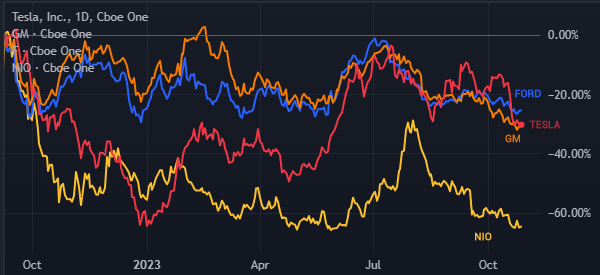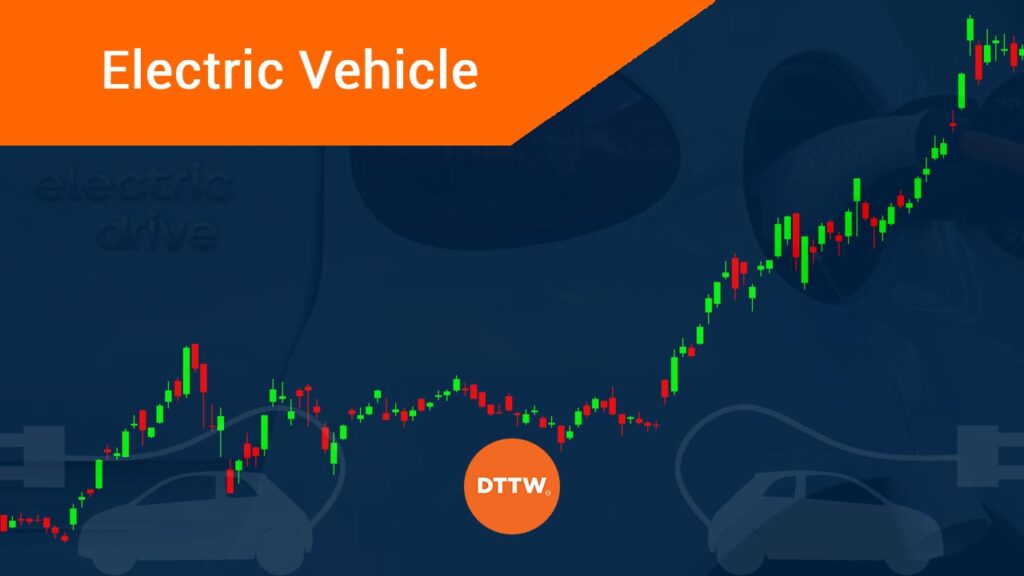The automobile industry is going through major changes as concerns about climate change remain. Many governments, especially in western countries, have made net-zero pledges that aim to shift the industry from Internal Combustion Engine (ICE) to EVs.
The implication of all this is that the number of car companies has soared globally. For example, China now has over 100 EV companies. The other change is that traditional companies like Toyota, General Motors, and Ford have announced entry into the industry.
This article will look at the EV industry, look at some of the top EV stocks to trade, and also explore the future of the industry.
Contents
Global EV sales are soaring
The automobile industry is one of the biggest ones globally. It is responsible for millions of jobs, directly and indirectly. As a result, the number of total EV sales are surging as the quality of these vehicles jump and as governments offer subsidies to buyers.
At the same time, competition is rising in the industry, leading to a price war, which is making these vehicles more affordable. At their peak, EV were selling for more than $60,000. Today, some Chinese companies are selling EVs for less than $20,000.
Recent data shows that many EV companies are seeing robust sales. Tesla, which began selling vehicles a few years ago, is on track to sell over 1 million vehicles in 2023. In total, estimates are that over 13 million EV cars will be sold in 2023. Estimates are that EVs will account for two-thirds of all vehicles sold in 2030.
There are other reasons why EVs are rising. First, the price of crude oil has surged, leading more people to move to EVs, which are cheaper to maintain. Second, EVs are now extremely appealing, thanks to advertisements in the industry.
Third, EVs have increased their range dramatically. Some vehicles can go for more than 600 miles in a single charge. Further, charging infrastructure has risen sharply in the past few months.
Is the EV bubble bursting?
As always, investors tend to move to new and emerging technologies. In 2023, we saw them move to Artificial Intelligence (AI) stocks like AITX and C3.ai. Similarly, in late 1990s and early 2000s, they moved to dot com companies.
This trend leads to the creation of bubbles, which always end in tears. We have seen the same situation happen in the EV industry as investors sought to catch the next Tesla. At their peak, many EV stocks surged.
For example, Rivian stock soared after going public in 2021. At its peak, the company had a market cap of over $120 billion, making it bigger than Ford and GM. Similarly, Lucid’s market caps soared to over $40 billion.
The same bubble happened in China, where over 500 EV companies were started. By 2023, over 400 of them had collapsed. The chart below shows the share prices of some of the top EV stocks and how they crashed.

Why did the EV bubble burst?
There are several reasons why many EV stocks have crashed and some gone bankrupt. First, while EV prices have retreated recently, they are still more expensive than ICE cars. As such, people are now buying ICE cars that they know well.
Second, range anxiety is a major issue since the charging infrastructure is not all that good. For one, it takes longer to charge EVs than fill a gas tank. Also, while people living in standalone houses can install chargers, those living in apartments cannot do that.
Third, there are concerns about the regular power outages even in key developed countries like the US. Further, there is the status quo bias where people prefer vehicles that they know well.
Also, there are concerns about how green EVs are since they are powered by energy that comes from fossil fuels like coal and natural gas.
Most importantly, the EV industry is a cash-burning one, especially in their early years. As such, while these companies could do well in a low-interest rate environment, many of them struggled when rates started rising. For example, after raising over $12 billion during its IPO in 2021, it had burnt half of it in 2023.
Examples and types of EV cars to day trade
There are four main types of EV cars that you can day trade or invest in. In this part, we will look at some of them.
Pureplay EV companies
The first category is pureplay EV companies. These are firms that design, manufacture, and sell EV cars only. Some of these firms include Tesla, Mullen Automotive, Workhorse Group, and Rivian Automotive.
Diversified auto companies
The next category is made up of companies that are diversified. This includes traditional car companies that sell ICE vehicles and EVs. Most traditional firms like Ford, General Motors, Stellantis, and Volkswagen are in this category.
Domestic and international brands
Further, you can invest in domestic and international car companies. American domestic firms include the likes of Tesla and Rivian. International firms, on the other hand, include the likes of Nio, Xpeng, Byd, and Li Auto.
EV infrastructure companies
The other type of EV companies to invest and trade in are those that provide infrastructure and other products. For example, there are firms like ChargePoint that provide charging stations in the US. Also, there are companies like Quantumscape that are doing research on batteries.
How to trade EV stocks
The most direct approach for trading EV stocks is to focus on companies that manufacture these vehicles. As mentioned above, some of these companies are Tesla, Polestar, Nio, and Xpeng among others.
The other approach is to trade contracts for differences (CFDs). A CFD is a financial asset that tracks the price of an asset without necessarily owning the real item. CFDs are great because they let you buy and short these EV stocks.
Further, you can also trade EV futures and options. A futures contract is where you have a right and obligation to buy or sell a stock when it reaches a certain price at a certain period. An option, on the other hand, gives you a right but no obligation to buy or sell the stock.
Additionally, you can trade ETFs that track EV companies and ETFs in the industry. Some of the top ETFs to consider are Amplify Lithium & Battery Tech ETF (BATT), SPDR S&P Kensho Smart Mobility ETF (HAIL), KraneShares Electric Vehicles & Future Mobility Index ETF (KARS), and YieldMax TSLA Option Income Strategy ETF (TSLY).
What moves EV stocks?
There are several factors that affect the prices of EV stocks. First, these shares move because of policy issues by key governments. For example, EV shares surged after several governments like in the UK and Europe announced plans to phase out ICE vehicles.
Second, these stocks move because of monthly deliveries. Most EV companies publish their deliveries every month. In most cases, these shares tend to rise or fall because traders use this data to predict their earnings and growth.
Third, EV companies are moved by corporate earnings. Earnings provide more data about whether a company is doing well or not.
In most periods, EV stocks rise after strong earnings reports and vice versa. In this regard, you should always use the earnings calendar to know when EV companies are about to publish their earnings.
Further, these stocks move because of interest rates since many people buy vehicles in credit. As such, high interest rates lead to weaker demand for vehicles and lower prices.
Top EV stocks trading strategies
There are several strategies you can use to trade the EV industry. First, you can use the long/short approach, where you buy the best EV stocks and short the weak ones. You should always limit your shorts because they have an infinite loss potential.
Second, you can trade EV news. Some of the top EV news to consider are earnings, vehicle deliveries, and capital raising. Third, you can use the trend-following strategy. This is where you look at an existing trend and follow it.
Fourth, you can decide to trade reversals. A reversal is a situation where a stock moving in one direction changes direction and starts moving in the other direction. After identifying a trend, you can use chart patterns or indicators to find the reversal.
Further, you can use several indicators like moving averages, Relative Strength Index (RSI), Stochastic Oscillator (SO), and the MACD to find opportunities. You can also use chart patterns like rectangles, triangles, and head and shoulders to find entry and exit trades.
FAQs
Which are the best EV stocks to trade?
Some of the best EV stocks to day trade are Tesla, Nio, Xpeng, Rivian, and Lucid. These stocks have high liquidity and are popular among traders and investors.
What is the future of EVs?
Analysts believe that EVs will continue growing and gain market share in the next few years. However, the industry has major issues that it needs to overcome like range anxiety, costs, and infrastructure.
Is the EV bubble bursting?
Like all industries, the EV industry went through a major boom during the pandemic since interest rates were at record lows. The sector then burst when interest rates surged as the Fed battled the rising inflation.
External Useful Resources
- Time for a Serious US Electric Vehicle Manufacturing Strategy – IndustryWeek
- A Complete Guide To Hybrid And Electric Cars – Vehiclefreak



